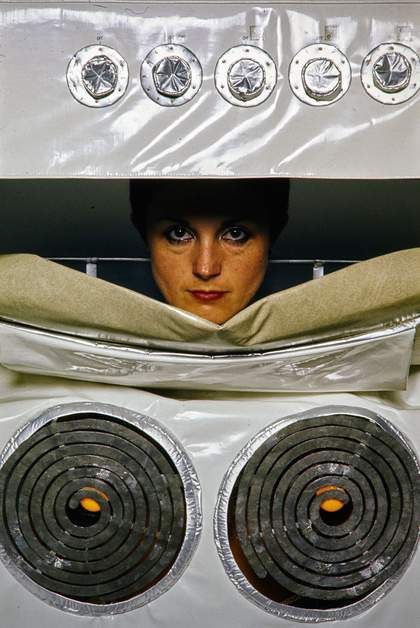
Helen Chadwick, In the Kitchen (Stove) 1977. © The Estate of the Artist. Courtesy Richard Saltoun Gallery, London and Rome

Helen Chadwick, In the Kitchen (Stove) 1977. © The Estate of the Artist. Courtesy Richard Saltoun Gallery, London and Rome
This autumn, Tate Britain will present Women in Revolt!, a landmark exhibition of feminist art in the UK from 1970 to 1990. It will explore how interconnected networks of women used radical ideas and rebellious methods to make an invaluable contribution to British culture. Showcasing work by over 100 women artists and collectives living and working in the UK, this will be the first major survey of its kind.
Painting, drawing, photography, textiles, printmaking, film, sculpture, and archival materials will be brought together to map a landscape of creative practice forged against a backdrop of extreme social, economic, and political change. As well as celebrating the work of well-known artists such as Sonia Boyce, Susan Hiller, Chila Kumari Singh Burman and Linder, Women in Revolt! will platform many women, who despite long careers, have been largely left outside the artistic narratives of the time. Shown in a major institutional exhibition for the first time will be works by Poulomi Desai and Shirley Cameron among many others.
Presented chronologically, the exhibition will begin with the first women’s liberation conference in the UK, Miss World protests and the formation of the Brixton Black Women’s Group. Artists such as Margaret Harrison, Penny Slinger and Monica Sjöö subvert the expected roles of women in society, while Kate Walker, Monica Ross and Su Richardson worked collectively on a postal art project, demonstrating how communities of women found ways to work collaboratively without formal infrastructure. Many of these pieces have not been shown since the 1970’s.
This period saw a dramatic evolution of the relationship between women, work, and the domestic environment. Frustration with an expectation of domestic labour is the subject of work by Bobby Baker, posters by See Red Women’s Workshop and photography by Alexis Hunter, whilst The Hackney Flashers and Tina Keane consider the social and political implications of raising children in Who’s Holding the Baby 1978 and Clapping Songs 1979. Sculptures by Rita McGurn and Elizabeth Radcliffe offer glamorous imagined images of the self, using techniques like crochet: often underappreciated because of their connection to domestic labour.
The exhibition will explore the creative impact of Punk and Post-punk with collage, photography and film from artists and musicians like Marianne Elliott-Said (A.K.A Poly Styrene), The Neo Naturists, and Gina Birch. The consideration of sex in the practice of artists is also explored, from Cosey Fanni Tutti’s performance work to Jill Westwood’s Potent Female, 1983. Protest led by women is a core theme throughout the show. Banners, posters, and journals from the Greenham Common and Section 28 protests, and anti-racism and AIDS campaigns are accompanied by documentary photography from Format Photography Agency, Mumtaz Karimjee, Bhajan Hunjan and Caroline Coon, affirming women’s central role in this activism. A major sculpture by Margaret Harrison which references the fences of Greenham Common will be installed alongside protest banners by Thalia Campbell.
The impact of women artists who were involved in key movements like the BLK Art Group and the advocacy group and archive Panchayat will be explored, as well as their role in the first National Black Art Convention in 1982 and ongoing contribution to British Black and South Asian feminist art discourses. Alongside works by key figures like Lubaina Himid, Sutapa Biswas, Claudette Johnson, Pratibha Parmar and Rita Keegan are works which are being specially conserved for the exhibition such as Nina Edge’s Snakes and Ladders 1985, an installation made of batik on paper and ceramics, which despite featuring on the cover of fellow exhibitor Maud Sulter’s landmark 1990 book Passion: Discourses on Blackwomen’s Creativity, has not been shown in over three decades.
The exhibition will close with work made towards the end of the Thatcher administration, focusing on women’s response to Section 28, the visibility of lesbian communities and the AIDS epidemic by artists including Del LaGrace Volcano, Tessa Boffin and Jill Posener. Women in Revolt! concludes with works that reflect on the changing economic landscape and women’s place within it by Joy Gregory, Franki Raffles and Roshini Kempadoo.